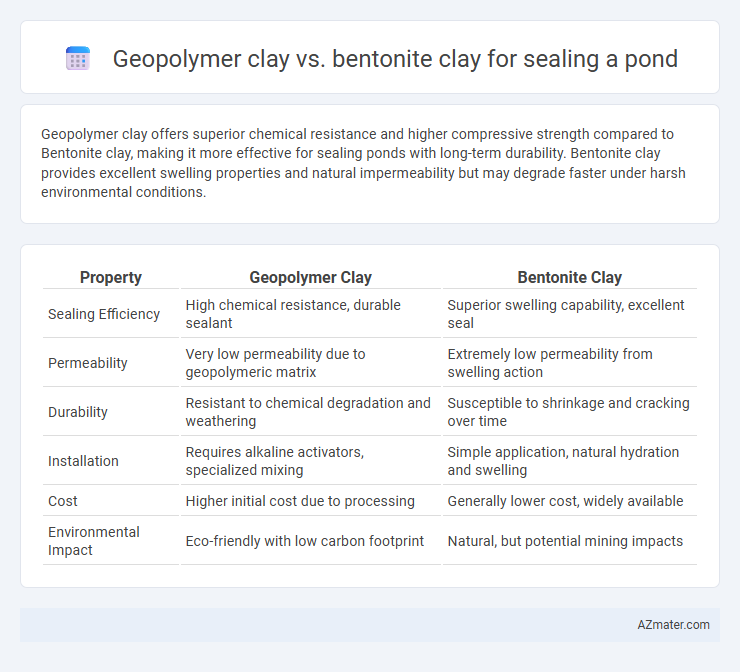Geopolymer clay offers superior chemical resistance and higher compressive strength compared to Bentonite clay, making it more effective for sealing ponds with long-term durability. Bentonite clay provides excellent swelling properties and natural impermeability but may degrade faster under harsh environmental conditions.
Table of Comparison
| Property | Geopolymer Clay | Bentonite Clay |
|---|---|---|
| Sealing Efficiency | High chemical resistance, durable sealant | Superior swelling capability, excellent seal |
| Permeability | Very low permeability due to geopolymeric matrix | Extremely low permeability from swelling action |
| Durability | Resistant to chemical degradation and weathering | Susceptible to shrinkage and cracking over time |
| Installation | Requires alkaline activators, specialized mixing | Simple application, natural hydration and swelling |
| Cost | Higher initial cost due to processing | Generally lower cost, widely available |
| Environmental Impact | Eco-friendly with low carbon footprint | Natural, but potential mining impacts |
Introduction to Pond Sealing with Clays
Geopolymer clay offers enhanced chemical resistance and durability compared to traditional Bentonite clay, making it a robust option for pond sealing. Bentonite clay is widely used due to its high swelling capacity and ability to create an impermeable barrier by absorbing water and expanding. Selecting between geopolymer and Bentonite clay depends on factors like site conditions, pond size, and required long-term performance for effective sealing.
What is Geopolymer Clay?
Geopolymer clay is an engineered material formed by activating aluminosilicate minerals with alkaline solutions, creating a durable, chemically resistant, and low-permeability binder ideal for sealing applications. Compared to bentonite clay, which relies on swelling properties to create a seal, geopolymer clay offers enhanced structural stability and resistance to acidic or saline pond environments. Its ability to form a strong, cohesive barrier makes it a superior choice for long-term pond sealing and water retention.
Understanding Bentonite Clay
Bentonite clay is a highly absorbent natural clay composed primarily of montmorillonite, renowned for its exceptional swelling properties when exposed to water, which create an impermeable barrier ideal for sealing ponds. Unlike geopolymer clay, bentonite's ability to expand up to 15 times its dry volume ensures effective containment of water, preventing seepage and maintaining pond integrity. Its cost-effectiveness, natural abundance, and proven long-term sealing performance make bentonite clay a preferred choice in hydraulic engineering and environmental containment applications.
Key Differences between Geopolymer and Bentonite Clays
Geopolymer clay exhibits superior durability and chemical resistance compared to bentonite clay, making it ideal for long-term pond sealing applications. Bentonite clay's high swelling capacity enables effective sealing by forming an impermeable barrier, whereas geopolymer clay relies on its synthetic polymer matrix to achieve low permeability. The environmental impact of bentonite is minimal due to its natural origin, while geopolymer clay involves complex manufacturing processes but offers enhanced mechanical strength and stability.
Sealing Efficiency: Geopolymer vs Bentonite Clay
Geopolymer clay exhibits superior sealing efficiency for pond sealing due to its enhanced chemical stability and lower permeability compared to bentonite clay. While bentonite clay swells upon hydration creating a natural barrier, geopolymer clay forms a dense, mineralized matrix that prolongs water retention and resists erosion. Empirical studies consistently show geopolymer clay achieving infiltration rates as low as 10^-9 m/s versus bentonite's typical 10^-7 to 10^-8 m/s, making geopolymer clay a more effective long-term sealing material.
Environmental Impact and Sustainability Comparison
Geopolymer clay offers a lower environmental impact than bentonite clay due to its production from industrial waste materials such as fly ash and slag, reducing landfill burden and greenhouse gas emissions. Bentonite clay, while natural and abundant, often involves energy-intensive mining and transportation processes that contribute to habitat disruption and carbon footprint. The sustainability of geopolymer clay lies in its potential for resource recycling and durability, making it a more eco-friendly choice for pond sealing compared to the traditional bentonite alternative.
Cost Analysis: Geopolymer Clay vs Bentonite Clay
Geopolymer clay typically offers a lower overall cost compared to bentonite clay due to its use of locally sourced industrial byproducts such as fly ash, reducing raw material expenses and minimizing transportation fees. Bentonite clay, while highly effective for sealing ponds due to its expansive properties, often entails higher costs associated with mining, processing, and shipping, especially when sourced from specialized deposits. Cost analysis must also consider long-term performance and maintenance, where geopolymer clay's durability and chemical resistance can translate into lower lifecycle expenses compared to bentonite's susceptibility to erosion and contamination.
Installation Process and Ease of Use
Geopolymer clay offers a straightforward installation process due to its premixed, homogenous material compatibility, allowing for easy application and faster setting times compared to bentonite clay. Bentonite clay requires careful moisture control and compaction during installation to ensure optimal swelling and sealing performance, which can make the process more labor-intensive and time-consuming. The ease of use favors geopolymer clay in projects demanding quick turnaround, while bentonite remains preferred for natural, flexible sealing where site conditions allow slower, more precise handling.
Longevity and Maintenance Considerations
Geopolymer clay offers superior longevity compared to bentonite clay due to its enhanced chemical stability and resistance to erosion, making it ideal for long-term pond sealing projects. Bentonite clay requires regular maintenance as it can desiccate and crack under fluctuating moisture conditions, reducing its sealing effectiveness over time. The low permeability and self-healing properties of geopolymer clay significantly reduce maintenance needs and extend the operational lifespan of pond liners.
Choosing the Best Clay for Pond Sealing Needs
Geopolymer clay offers superior chemical resistance and durability compared to Bentonite clay, making it an excellent choice for pond sealing in environments with acidic or contaminated water. Bentonite clay is highly effective due to its natural ability to swell and create a watertight seal, especially in freshwater applications requiring flexible and cost-efficient solutions. Selecting the best clay depends on specific pond conditions, such as water chemistry, soil compatibility, and budget constraints, with geopolymer clay favored for longevity and Bentonite for ease of installation.

Infographic: Geopolymer clay vs Bentonite clay for Sealing pond
 azmater.com
azmater.com